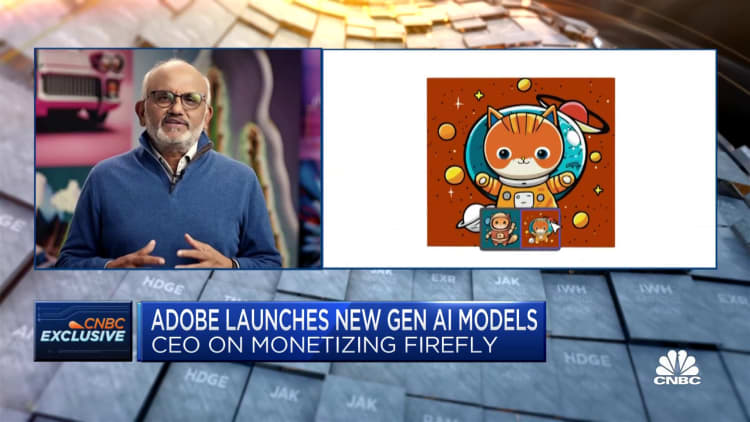Billionaire Silicon Valley technology leader Romesh Wadhwani, 75, is investing $1 billion of his personal fortune in predictive and generative AI technology.
SAIGroup
Billionaire Silicon Valley technology leader Romesh Wadhwani recently celebrated his 75th birthday with 100 friends, reminiscing about many career milestones and only wishing he were 20 years younger in a new, fast-moving era of artificial intelligence.
“AI tech is in an explosive phase right now, when I feel like I am falling behind every week. Gen AI is happening weekly. Every job, every consumer, every company will be massively transformed,” he said.
Wadhwani signed the Gates Buffet Giving Pledge to give away the majority of his wealth, but $1 billion of his fortune is currently being bet on predictive and generative AI technology. “We are going for it, transforming as a Gen AI-first company,” said Wadhwani, now chairman and founder of investment firm SAIGroup and its portfolio of three enterprise AI software technology companies.
From his headquarters at Stanford Research Park in Palo Alto, Wadhwani recounted several cycles in AI’s development over his 53-year career journey: from the 1970s as a concept, to robotics in the 1980s, to cloud computing and greater computing power in the 1990s, to the 2020s with massive data availability.
“Each wave was followed by an AI winter. Now, we are moving at lightning speed. … What AI will enable in the next five years, we were not able to do in the past 50 years,” he said.
Market research company Forrester forecasts enterprise AI software spending will reach $60.4 billion globally in 2023 and balloon to $227 billion by 2030 while GenAI will capture 55 percent of this AI software market by the end of the decade. “There is a sense of urgency,” said Mike Gualtieri, vice president and principal analyst at market research group Forrester. “The concern in business is that some company in the industry will be first to use this new AI technology for competitive advantage.”
Currently, slightly more than half (53.5%) of large enterprises have adopted AI software, with much smaller percentages among small and medium-sized businesses, according to Forrester. Far wider use is forecast by Forrester by 2030.
Adobe CEO Shantanu Narayen, who has known Wadhwani in the circle of successful Indian immigrants in Silicon Valley for several years, praised him for being “very, very early in AI, way before this AI craze.”
From the start, SAIGroup’s strategy was differentiation. “If only doing horizontal AI, that was already being done by Facebook and Google, and there was no chance of competing with the behemoths. I did a startup for the most important verticals where AI can provide the most value,” Wadhwani said.
The early results for the largest tech companies in the stock market are in, with recent gains propelled by a combination of AI substance and hype. Roughly one year since ChatGPT’s launch in late November 2022, megacap tech and chip makers have surged, with Nvidia up roughly 175%, and Microsoft gaining nearly 50% tied to the billions of dollars it has invested in ChatGPT maker OpenAI.
Wadhwani began building his enterprise AI software business in 2017, when he says the AI era for business was still early in its development. SymphonyAI came together through a series of startups and acquisitions, positioned for retail, consumer packaged goods, financial services, manufacturing, media and the public sector. Building on the momentum, he expanded the business with two more health industry-specific AI companies. ConcertAI, launched in 2018, is pinpointing biotech. RhythmX AI, rolled out this October with a $50 million investment and run by CEO Deepthi Bathina, former chief clinical product officer at Humana, is getting started as a GenAI-based platform for physicians and healthcare systems to offer personalized patient care.
Boston-based ConcertAI, split off separately from SymphonyAI in 2018, has grown revenue by 35% to $160 million. Its mission is to accelerate cancer research and match patients with clinical trials. “His (Wadhwani’s) vision on how AI, research and healthcare pieces can come together and be transformative plus his commitment, is extraordinary. It is not just an AI investment thesis,” said CEO Jeff Elton. Last year, ConcertAI scored $150 million in venture capital at a $1.9 billion valuation, and has raised a total $600 million.
Bristol Myers Squibb, a ConcertAI customer for five years, uses its software for clinical trials in oncology research. “It offered a more robust and bespoke option for our clinical trials that didn’t exist in the market at that time,” said Jeff Conklin, who recently retired as senior vice president and chief analytics officer and had worked with Wadhwani to develop and customize oncology research software — the genesis for ConcertAI.
Veteran technology executive Sanjay Dhawan, who previously ran Wadhwani-invested Symphony Teleca and was recruited by Wadhwani in early 2022 as SymphonyAI CEO, said the company recently turned profitable and is approaching $500 million in revenue run rate for 2023, growing by 30 percent yearly. The goal is to take SymphonyAI public within 18 to 24 months.
“I feel good that the original vision of 2017 is unfolding, and the strategy is paying off,” Wadhwani said.
Forrester’s Gualitieri predicts that smaller vendors with domain expertise may have the advantage in moving faster than big companies. But as in prior hyper-cycles for new technologies, the field is getting crowded, even in the verticals where SAIGroup is focused. It competes with AI enterprise software innovators on two fronts. Rivals include vertical specialists such as Actimize in fraud protection, Roche Group-acquired Flatiron in biotech, and Ansys in product design. Also factoring in as rivals are horizontal AI providers, like publicly traded C3.ai and Palantir Technologies. Meanwhile, upstarts in Gen AI keep coming such as Eric Schmidt-funded Mistral AI from France, for enterprises.

“No could have predicted AI could do 80% of what it does today,” said Wadhwani, who gets weekly high-tech updates from his team.
Customers for the group’s SaaS AI tools come from the U.S., Europe and Asia and include grocery retailers, consumer packaged goods companies, financial services and pharmaceutical makers as well as big company brands Procter & Gamble, Nationwide and Pfizer.
Supermarket chain Save A Lot recently selected SymphonyAI technology to better manage its supply chain, after a three-year evaluation of providers. The data-driven retail technology “stood out as a best-in-class AI solution with a full suite of warehousing, vendor management and forecasting,” said chief information officer Jennifer Hopper.
A graduate of the Indian Institute of Technology, Bombay, Wadhwani came to the U.S. from India on a fellowship at Carnegie Mellon University, where he earned his Master’s and PhD degrees in electrical engineering. He had pioneering AI research scientists Allen Newell and Herbert Simon as professors. His first business out of college in Pittsburgh was security and energy software company Compuguard, a $10 million business sold in 1981 to Swiss electrical equipment maker Brown Boveri.
Then, in 1982, he signed on as CEO of American Robot Corporation, backed by the Rockefeller family’s venture fund Venrock. Struggling to compete with lower-cost Japanese robotics makers, he transformed the money-losing business into computer-aided software for manufacturers and returned most of the original VC investment. “I was putting in work weeks of 80 to 90 hours and earning what amounted to $13 to $14 hourly,” recalled Wadhwani. “I wasn’t a very disciplined operator for the first 20 years of my career. “But I learned about capital efficiency and how to operate a company with discipline and not just a good vision.”
Eager to try his luck in tech capital Silicon Valley, in 1991, Wadhwani convinced his wife to make a move from Pittsburgh “to be where the big dogs are.” He soon started business-to-business software service Aspect Development. Within 10 years, by 2002, a competitor in the booming e-commerce sector, i2 Technologies, bought Aspect Development for $9.3 billion in stock, and the two companies were combined. Wadhwani said he keeps a framed Wall Street Journal article in his office about the deal, then described as the “largest software deal ever.”
Looking for his next challenge, in 2002, he formed private equity firm Software Technology Group. “I could have done another startup, but I decided instead to do a whole bunch of startups and acquisitions,” he said. Through three funds totaling $1.8 billion with Wadhwani as a primary backer, STG invested in 33 companies in the enterprise software space. “It was an exhilarating, high energy time,” he said. There were no failures and no shutdowns from those portfolio companies. Among the wins was the acquisition of software integration service Symphony Teleca for $780 million in 2015 to Harman, a specialist in audio technologies.
Now at the helm of SAIGroup and its three operating companies, Wadhwani says he puts in 70-80 hours per week, yet finds time to enjoy listening to music and reading nonfiction books. He handles most calls and meetings from his mansion in the affluent small city Los Altos. “I feel like I’ve achieved a lot but never had the grandiose vision of an Elon Musk building a trillion-dollar EV business or completely changing space travel,” Wadhwani said.
Prepping for a possible IPO within two years, SymphonyAI has recently named three new board members: Blythe Masters, a British private equity executive and former JPMorgan Chase executive; Daniela Rus, director of the MIT Computer Science and Artificial Intelligence Laboratory; and Todd Harbaugh, a retired executive vice president at Walmart.
Meanwhile, Wadhwani is keeping his eye on the long-range, ethical advancement of AI technology. This past April, he committed $5 million to form the Wadhwani Center for AI and Advanced Technologies at research policy organization Center for Strategic and International Studies in Washington, D.C. Its directive is to “help frame the right policies for AI governance,” he said, to “keep optimistic, but also have guard rails.”

